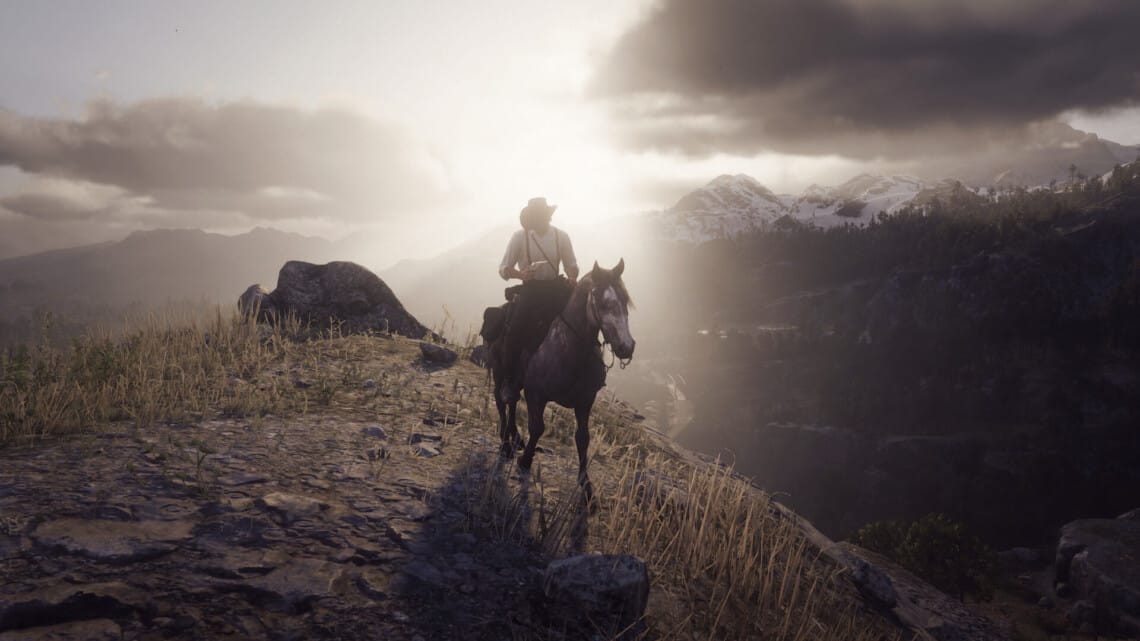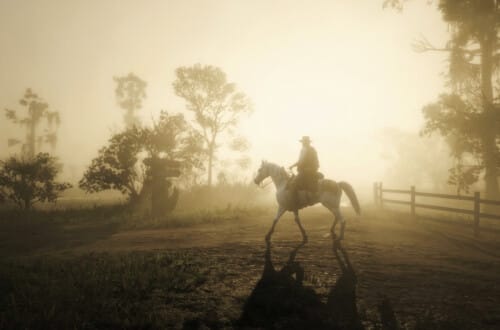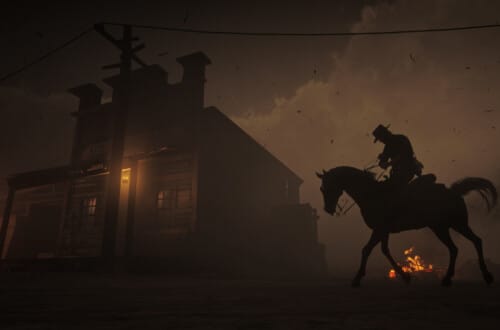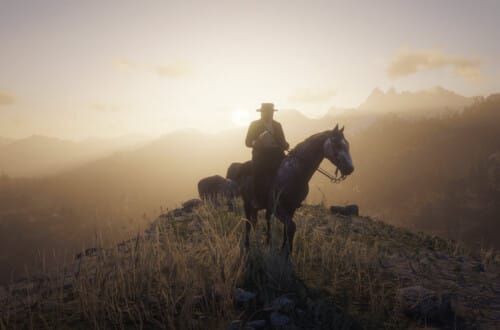Part I: Permeability
How toxic masculinity and homophobia shape the narrative of RDR2.
All articles on this site feature detailed discussion of literary allusions in Red Dead Redemption 2, and as such contain unmarked major and minor spoilers for the game, and occasionally the eventual fates of some characters in Red Dead Redemption. Read at your own risk.
Paradise Lost and Arthurian legend are both so steeped in misogyny that removing it would transform either work unrecognizably. Eve, as Milton infamously writes her, is a dim-witted, sexy doll, if a doll could also be evil. This conception of Eve connects directly to the chivalric treatment of women. Many people take offense at the idea that chivalry is misogynistic because they think of it as “being nice to women,” when its real function is to infantilize and patronize women based on the presupposition that they are lesser beings that must be guided and taken care of – Eves who must be protected from their own sinful nature. Under this ideology, women are object-children to be indulged, but never respected as men are. Consider the example of Le Morte Darthur’s Sir Persant, who sends his (unnamed) virgin daughter to sleep with their guest, Sir Beaumains:
Sir Persant had a daughter, a fair lady of eighteen year of age, and there he called her unto him, and charged her and commanded her upon his blessing to go unto the knight’s bed and lie down by his side, ‘and make him no strange cheer, but good cheer, and take him in your arms and kiss him; and look that this be done, I charge you, as ye will have my love and my good will.’
Malory 137
As I’ve shown, Dan Houser, Michael Unsworth, and Rupert Humphries drew heavily on Paradise Lost and Arthurian legend to write Red Dead Redemption 2. Between that fact, the misogyny inherent to the Western genre, and Rockstar’s notorious portrayal of women, it’s imperative to make an honest inquiry into how misogyny appears in the game. As it happens, doing so illuminates why the game’s narrative fails in the precise way that it does.
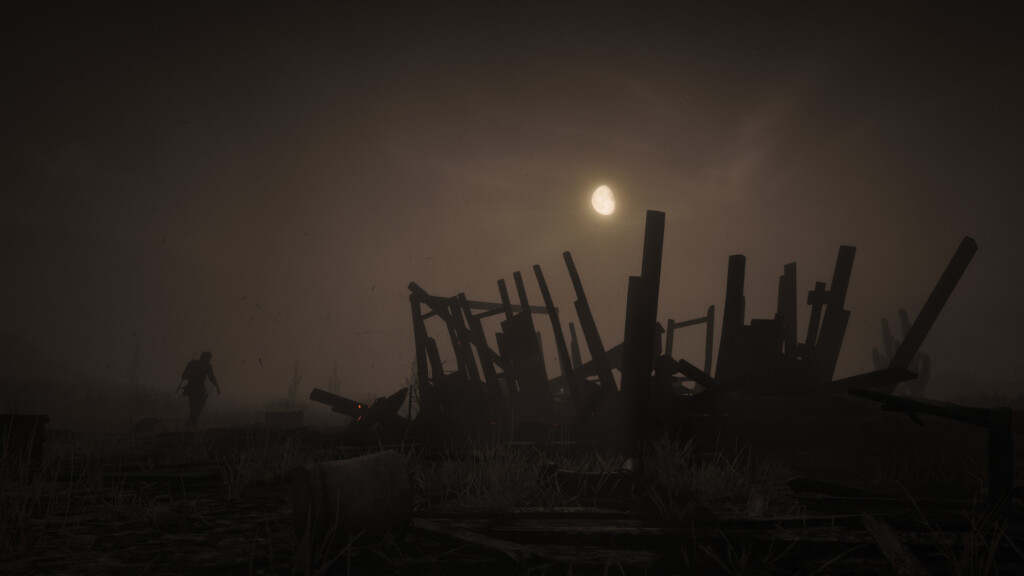
Masculinity as a Prison
Men are a necessary starting point for understanding how women are portrayed in Red Dead Redemption 2, because just as racism is a problem rooted in a certain idea of whiteness, misogyny is a problem rooted in a certain idea of masculinity. That same idea of masculinity is the arid, crumbling soil of the Western. In her major study of the genre, West of Everything, Jane Tompkins finds that the Western was created as a response to, and rejection of, the values of the sentimental novel. These domestic, religious novels were immensely popular in the 19th century, and female authors found major success with them. In the Western, male authors created worlds that were everything the sentimental novel was not. As Tompkins puts it, the genre “is about men’s fear of losing their mastery, and hence their identity, both of which the Western tirelessly reinvents” (45).
As anyone familiar with Rockstar would expect, RDR2 is pretty unenlightened in its concept of gender. That said, the game’s presentation of masculinity is more complicated than first meets the eye. Neither Redemption game is wholly satisfied with the John Wayne standard of masculinity. Matt Margini’s commentary on the first game is also illuminating when considering the second:
As game critic Jess Joho has noted, the game shows us that the true villain responsible for John’s fall is not Bill Williamson, Dutch van der Linde, or even the government agents who execute him; “the blame rests squarely on the false promises of a world built on hypermasculine ideals.” Scenes between John and his son, Jack, make this clear: Even though John tries to play the role of a caring and empathetic father, even though he tries to adopt a new model of masculinity, it’s too little, too late; his son fixates on replicating all the macho, gunslinger bullshit.
“Cowboy”
The second game, too, troubles and is troubled by those “hypermasculine ideals.” Dapper Josiah Trelawny frets at Arthur, “I know you think I’m just some effete buffoon. A man of words and not of action … hardly a man at all” (“Friends in Very Low Places.”) “I think you’re as slippery as an eel in an oil slick, but still a man,” Arthur grumpily reassures him. (Trelawny is “still a man,” but presumably Arthur’s ruggedness makes him more qualified to be the arbiter of the masculine gender.)
Arthur himself is, in many ways, what the Western wants to think a man is. That can tend to obscure his totality. As a result, he’s often discussed in reductive terms. He’s burly, tough, violent, and rude. Considerations of his character frequently offer no more nuance than that. In fact, his complexity is one of the areas in which the game is more successful — albeit not in the sense that it most tries to argue, because the idea of his duality is never fully developed. Instead, consider the list of things from West of Everything that a cowboy must not do or be:
Striving to be the opposite of women, the male heroes restrict themselves to a pitiably narrow range of activities. They can’t read or dance or look at pictures. They can’t play. They can’t rest. They can’t look at the flowers. They can’t cook or sew or keep house, or carry on a conversation of more than a couple of sentences. They can’t not know something, or ask someone else the way. They can’t daydream or fantasize or play the fool. They can’t make mistakes.
127
Arthur Morgan alludes to Shakespeare in everyday conversation; dances with Mary-Beth Gaskill and Karen Jones and strangers in a bar; draws beautifully, assists a photographer, and goes to an art exhibition; plays games (not just poker or five-finger fillet, but dominoes with his female friends); rests when he’s ill or injured; keeps a flower by his bed in memory of his mother, gathers dozens of orchids for a queer man (and draws them, besides), admires the flower necklace Jack makes; has scores of long conversations (sometimes about his feelings); doesn’t know how to track, hunts and fishes poorly; learns practical skills from Charles and Javier, seeks advice from Sister Calderón; daydreams of a buck; acts an absolute fool when he’s drunk; and makes major and minor mistakes throughout the game. If he has a creed, it’s that vengeance is a foolish waste of time; elsewhere, Tompkins points out that traditionally, “love and forgiveness in place of vengeance” is “what women stand for” in the Western, and therefore what men reject (41).
Certainly, these are broad rules, and some of the cowboys Tompkins studied must break them sometimes. But Arthur Morgan breaks nearly all of them — the only things on her list that Arthur doesn’t do are sew and keep house. Obviously, that is not to say that he’s a perfectly enlightened vision of masculinity, or that he doesn’t fit the cliche mold of the Hollywood cowboy in many ways. However, something more complicated is happening in how he’s written.
As the story wears on, Arthur’s feminine-coded qualities become more pronounced: he’s more thoughtful, more prone to counsel peace, more likely to acknowledge and share his deepest feelings and trauma1. In the end, it doesn’t matter. Even as it attempts to imagine a more complex and whole vision of masculinity, Rockstar’s fear, hatred, or simple disregard of the feminine means that in the end, it chooses to embrace the shriveled image of the Western hero.
So what is it that Rockstar is afraid of?
The Permeable
A passage in Tompkins illuminates the incident around which RDR2‘s whole narrative hinges:
Drawing on Octavio Paz’s definition of the macho as a ‘hermetic being, closed up in himself'(‘women are inferior beings because, in submitting, they open themselves up’), [Peter] Schwenger shows the connections these authors make among speaking, feeling, and feminization. ‘It is by talking,’ he writes, ‘that one opens up to another person and becomes vulnerable. It is by putting words to an emotion that it becomes feminized. As long as the emotion itself is restrained, held back, it hardly matters what the emotion itself is; it will retain a male integrity.’ Thus, ‘not talking is a demonstration of masculine control over emotion’ (43-45).
Control is the key word here. Not speaking demonstrates control not only over feelings but over one’s physical boundaries as well. The male, by remaining ‘hermetic,’ ‘closed up,’ maintains the integrity of the boundary that divides him from the world. (It is fitting that in the Western the ultimate loss of control takes place when one man puts holes in another man’s body.) To speak is literally to open the body to penetration by opening an orifice; it is also to mingle the body’s substance with the substance of what is outside it. Finally, it suggests a certain incompleteness, a need to be in relation. Speech relates the person who is speaking to other people (as opposed to things); it requires acknowledging their existence and, by extension, their parity.
56
This view of masculinity allows us to understand “Money Lending and Other Sins III” as follows: In a heated physical confrontation, Arthur pins Thomas Downes to a fence. “You took the money. He wants it back. What’s not to understand?,” Arthur barks in Thomas’s face. He wants it back: Arthur is Strauss’s agent, having left himself open to be used according to Strauss’s will and against his own preference.2 As Arthur holds him fast, Thomas coughs up blood, partly due to the rough way Arthur has been handling him. He forcefully ejects fluid from his body, which spatters across Arthur’s face and enters his mouth: he penetrates Arthur with Death. (Tuberculosis is actually transmitted when an uninfected person inhales the bacteria. The blood is a visual hint of what cannot actually be seen, but it is also gratuitous.) Arthur wipes his face and spits in disgust, but his face and lips remain stained red with Thomas’s blood throughout the scene. It is failing to remain “closed up” — specifically to a man — that kills Arthur.
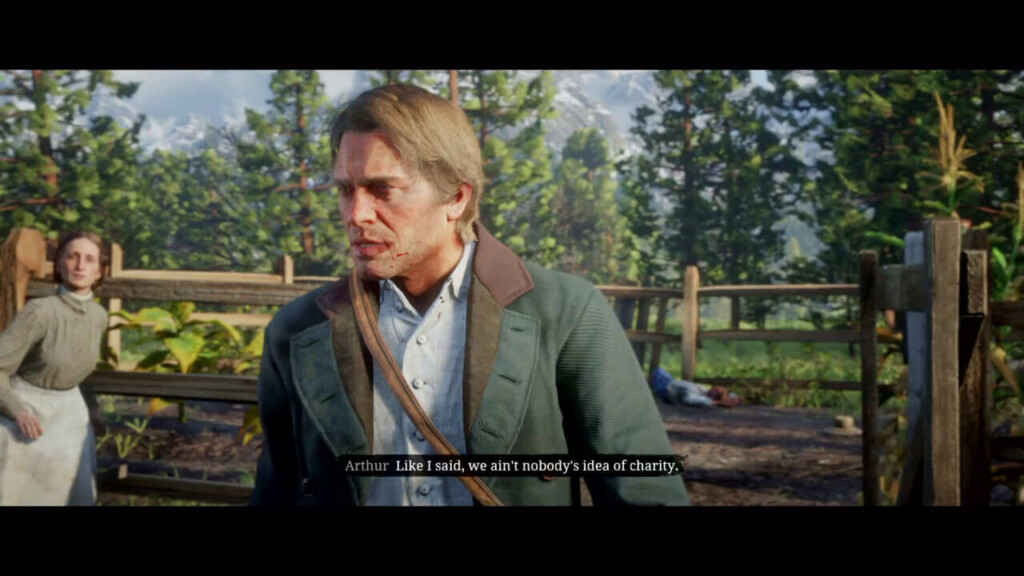
In opposition to Arthur, Thomas has what the Western tends to posit are feminine traits. Tompkins explains that the genre was partially created in reaction to women’s expanding role in society, especially their efforts in social reform (43). Downes can be found soliciting donations in Valentine — not for himself, but for The Charitable Organization Society of New Hanover, whose pamphlet details their plans to help people in need, in part through educational programs. Thomas also counsels forgiveness over vengeance: he has to beg Arthur to stop beating Tommy to death because he isn’t physically capable of stopping him.
What is transmitted to Arthur when he fails to maintain his masculine boundaries is not just Death, but Thomas’s feminine qualities: in Chapter 6, Arthur becomes weaker, more charitable, more merciful3. That these things have relatively positive narrative outcomes even as the game denigrates the feminine shows just how snarled a web it’s woven for itself.
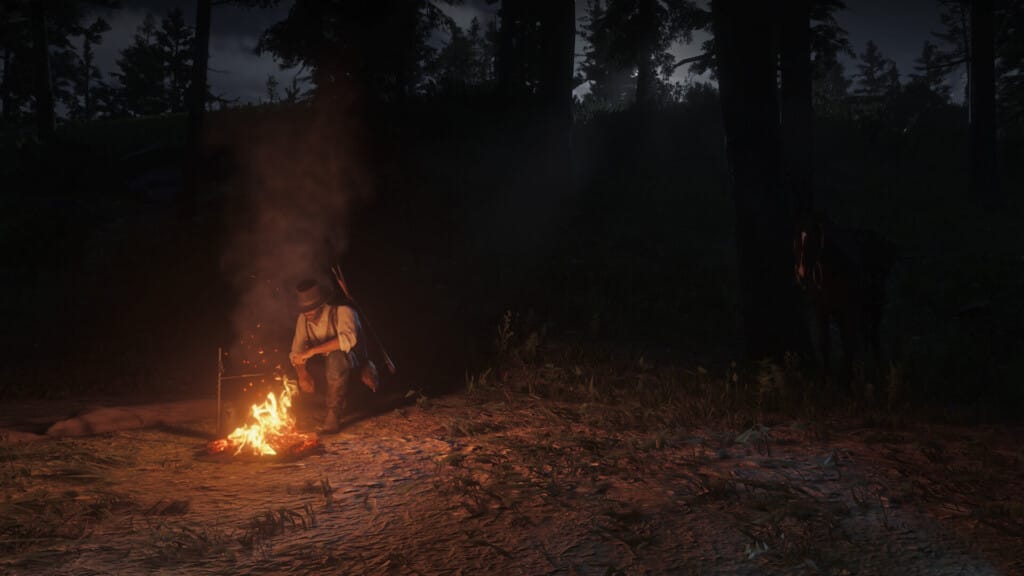
Homophobia in RDR2
Homosexuality has always been part of the Western: naturally, sometimes embracing the masculine and shunning the feminine is going to mean loving the masculine. And because human beliefs about gender roles and sexuality have always been flawed, the Western has always been anxious about homosexuality. Thomas Downes’ tubercular penetration of Arthur is just one instance of Rockstar betraying their own anxiety about, and loathing of, male homosexuality.
As is par for the course for Rockstar, marginalized people in RDR2 are usually portrayed in stereotypical ways (often in sad little attempts at humor). Several men in the game are queer-coded: Algernon Wasp is a flamboyant and dramatic fashion designer. Nicholas Timmins’ naive sister writes that she doesn’t know why he and another professor had to abruptly leave Princeton, and recalls how he used to braid her hair and put on her makeup4.
In another vein, RDR2 implies Bill Williamson is gay. Among several other odd little hints, his personal item in camp is a letter from the army dishonorably discharging him for “deviancy.” Historically (and still, among the ignorant), homosexuality was thought to be deviant. In a monologue that he begins by lying about that army discharge, Bill defensively declares that an apparent sexual partner “was a woman” to the giggles of his audience. In “Americans at Rest,” Arthur asks Charles Smith and Javier Escuella if Bill is “about to kiss that guy or punch him?” When Bill tells Micah that his birth name was Marion, Arthur joins Micah in cruelly mocking him. The only dialog option available is “Greet,” which results in the following bizarre exchange:
ARTHUR: Hey, there, Mary.
Observed: Horseshoe Overlook
BILL: Shut up.
ARTHUR: Sorry, ma’am.
The writers make fumbling, pained attempts to show that Arthur is “not racist” and “not sexist,” but apparently, homophobic and transphobic insults are on the table, provided you don’t like the person at whom they’re directed. Given that Tilly (whom the player is supposed to like) later mocks Bill for the same reason5 indicates that Arthur bullying Bill along with the game’s big villain is not a particular sign that the writers are aware that the behavior is shitty. That Arthur not only mocks Bill, but mocks him by calling him “Mary” — the name of the woman Arthur’s been in love with for over a decade — shows that Rockstar’s homophobic anxieties run deep indeed. It does not illuminate what those anxieties are so much as highlight their nonsensical nature: having what is now considered a feminine name6 makes a man indistinguishable from a woman? You might accidentally mistake him for the woman with whom you’re in love?
None of the game’s queer-coded characters are ones we’re particularly meant to respect: Bill — racist, unintelligent, devoted to a man who despises him, often pathetically wasted, wearing shit-stained underwear — is usually the butt of a sneering joke that goes right over his head. In contrast, Dutch Van der Linde — who we’re certainly meant to take seriously, even if we don’t like him — is based on an actual real queer man. Funny how the writers didn’t incorporate that crucial part of Lord Byron’s identity into Dutch’s character.
Nor is any of this the worst of the homophobia to be found in RDR2. In Red Dead Redemption, Captain de Santa is “a vicious sociopath who, the game not-so-subtly implies, derives his sadistic streak from repressed desire for other men” (Margini, “Revolution”). While the second game makes some paltry steps towards improving its portrayals of Native Americans, Black people, and women, the homophobia in RDR2 often seems decidedly worse than in its predecessor. The only time Arthur kisses (or rather, is kissed by) anyone is in “The Artist’s Way IV,” when Charles Châtenay, wearing drag, kisses him without consent. It’s an awkward, entirely unerotic moment; afterward, Arthur wipes his mouth just as he does after Thomas Downes coughs on him.
While that moment isn’t too alarming, it faintly echoes a deeply disturbing incident: in one of the game’s most poorly-advised narrative moments, a man may knock out and rape the player character7. RDR2 coyly hints that several male characters are gay, but the only actual sexual contact in the game between two men is violent, non-consensual, and frequently traumatic for players who encounter it.
And in Arthur’s worst possible death, the sexual connotations of the action are even more apparent and unsettling than in “Money Lending and Other Sins III.” After Dutch abandons them both, Micah tells him, “I must say, Arthur, it’s been a lot of fun.” Arthur is lying on his stomach, trying to crawl away. Micah approaches and stabs him — not in the heart, but in the lower back. The shot is framed so we see both men’s faces, but for a long moment after Micah stabs Arthur, we don’t see the knife: we see Micah crouching above him, his hand at the level of his crotch, the blade piercing Arthur in some shadowed place hidden from our view.
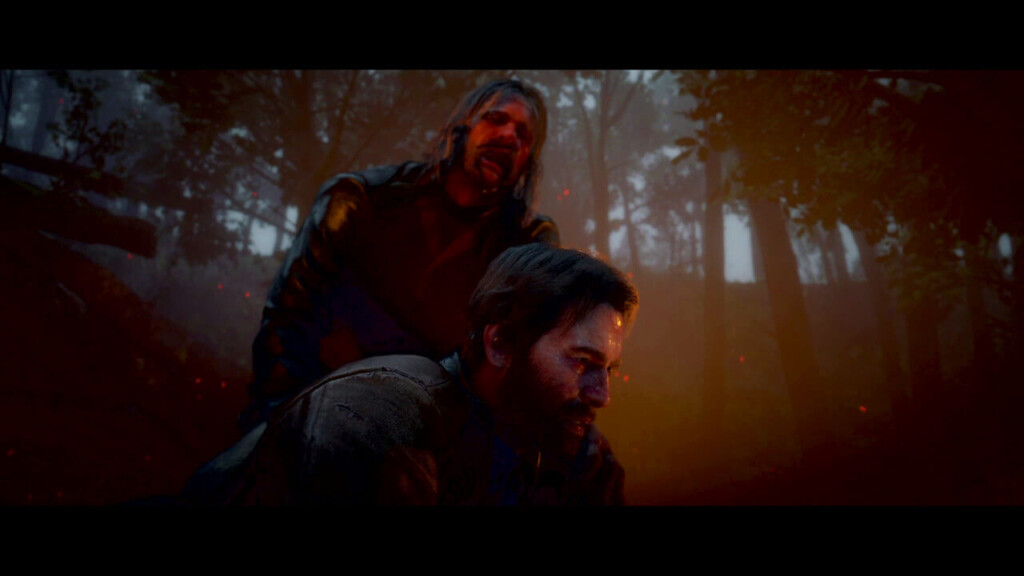
Micah keeps his hand on the grip — as if the instrument penetrating Arthur is an extension of his body — as Arthur cries out, tenses, and collapses in la grande mort: for the second time, a man penetrates him with Death.
Next week: In Part II of this essay, I discuss Rockstar’s limited acknowledgment of women’s personhood.
New here? Visit the Table of Contents to read the essays in order, or the Index & TL;DR to explore the site by topic. New essays are published Wednesdays at 1 p.m. E.T./10 a.m. P.T. Sharing the site is deeply appreciated! Follow me on Bluesky, Twitter, or Tumblr for updates.
- See, for example, “Just a Social Call,” “Favored Sons,” “Of Men and Angels II,” and “Archeology for Beginners.” ↩︎
- See Arthur’s journal entries about debt collection. ↩︎
- For instance, in “Money Lending and Other Sins VI” and “Do Not Seek Absolution” ↩︎
- “Letter to Mayor Timmins from Belinda,” which can be read here. The incident described in the letter is probably based on the persecution of gay literary critic Newton Arvin and his Smith College colleagues Edward Spofford and Raymond Dorius. All three men were forced to leave Smith after police found photos of “semi-nude men” in their possession (“Newton Arvin”). The link here is that Truman Capote created an award in Arvin’s honor (“Truman Capote Award for Literary Criticism”), and Houser bought Capote’s former townhouse (Zeveloff). ↩︎
- In Bill’s Companion Activity, available in Chapter 3. ↩︎
- It wasn’t in 1899. Of babies born in the 1880s — later than Bill was born, but as far back as Social Security Administration data is available — “Marion” was the 91st most popular name for boys, and the 123rd most popular name for girls. This is not even a conversation that would have happened. ↩︎
- For those made anxious by this, it will only happen if you enter the house of a creepy man (“Sonny”) in the Bayou just North of Saint Denis when he invites you in. ↩︎
Bibliography
Expand to view sources.
- Cantamessa, Christian, et al. “Red Dead Redemption.” Rockstar Games, 2010.
- Houser, Dan, et al. “Red Dead Redemption II.” Rockstar Games, 2018.
- Margini, Matt. Red Dead Redemption. BOSS FIGHT BOOKS, 2020.
- “Newton Arvin.” Wikipedia, Wikimedia Foundation, https://en.wikipedia.org/wiki/Newton_Arvin. Accessed 13 Dec. 2024.
- Tompkins, Jane. West of Everything: The Inner Life of Westerns. Oxford University Press, 1992.
- “Truman Capote Award for Literary Criticism.” Wikipedia, Wikimedia Foundation, https://en.wikipedia.org/wiki/Truman_Capote_Award_for_Literary_Criticism. Accessed 13 Dec. 2024.
- U.S. Social Security Administration. “Top names of the 1880s.” https://www.ssa.gov/oact/babynames/decades/names1880s.html.
- Zeveloff, Julie. “It Turns Out The Creator Of Grand Theft Auto Bought Truman Capote’s Brooklyn Townhouse For A Record Sum.” Business Insider. 21 Mar. 2012, https://www.businessinsider.com/it-turns-out-the-creator-of-grand-theft-auto-bought-truman-capotes-brooklyn-townhouse-for-a-record-sum-2012-3. Accessed 13 Dec. 2024.
